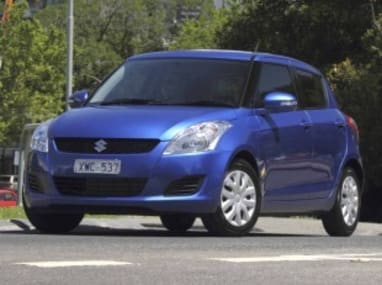Used Suzuki Swift review: 2005-2015
By Ewan Kennedy · 20 Nov 2015
Suzuki Swift was a big seller in Australia in the 1980s and '90s. Many were rebadged as Holdens and carried Barina badges. For some strange reason imports were stopped in 2000.Thankfully an all-new Swift was imported downunder beginning in February 2005 and is the subject of this week's used-car report.The chunky lines of the body pleased many and the new Swift was a hit from day one. Note that there are no Holden versions of these later models.The Suzuki Swift is a tough little machine that's well know for reliability and long life and has long been popular on the Australian used-car scene.They hold there value well and dealers complain they often can't get their hands on enough of them.Swift has a better sorted suspension and steering than most cars in its class and is appreciated by keen drivers.Good throttle response from the engines is another fun factor. Swift has good interior space for a car in this class.Obviously there isn't space for large adults, but the little Suzuki lets you juggle the seats to get the best from the interior space. The front seats have a good spread of fore-and-aft adjustment and the driver's seat can be raised and lowered.Boot space is good for a car of this size, though small in absolute terms. There's the usual option of folding down the seat back in various configurations to make it a better luggage carrier.A major model change in June 2011 retained the same cheeky look as the 2005 model, but is a little larger, with more space in the back seat.Power comes from a twin-cam, multi-valve engine, with a capacity of 1.5 litres in most of the original Swifts. The engine size on these standard cars was reduced to 1.4 litres in the 2011 Swift, but the new design of engine provides similar performance, uses less petrol and creates fewer emissions than the old 1.5.Unlike many so-called 'sports' models, the Suzuki Swift Sport has better engine and suspension performance than the standard Swifts. It has a larger engine, at 1.6 litres, to back up its firmer suspension, sporty body kit and enhanced interior. The Sport isn't what you would term a hot hatch but it gives you plenty of driving pleasure at a very modest price.Many Swifts in Australia have a five-speed manual gearbox, there's also the option of a four-speed automatic transmission. The auto doesn't take too much away from the performance of this relatively light car. The Swift Sport came only as a manual, a five-speed, until it was discontinued in 2011.There were no imports of the Swift Sport from June 2011 until February 2012 when the new series was introduced with a six-speed manual transmission and the option of a CVT, the latter has seven preset ratios so drivers can make their own choices.Though this is a small car there's quite good under-bonnet space so you can do your own basic servicing without knocking off too much skin.Buy a workshop manual before opening that bonnet, though. Leave anything that could affect safety to the professional mechanics.There are a reasonable number of Suzuki dealers in Australia, though they tend to be concentrated in the metropolitan and major country cities.We have heard of no real problems with spare parts supply and the prices aren't too bad for a fully imported car.Insurance costs are towards the lower end of the scale and we don't know of any companies that charge significantly more for the Sport versions.Be wary of a Swift that has been modified in the body and mechanicals as these may indicate it has had a hammering by a look-at-me driver. Big, noisy exhausts are a prime candidate for caution.Look for body damage and/or signs of it having been repaired.Check that the engine starts within a second of you turning the key, even if it's completely cold in the morning.If the engine hesitates on acceleration or during hard cornering there may be some water in the fuel rails causing a misfire.Fuel filler hoses and clamps were the subject of recalls in March and May 2012. Give a Suzuki dealer a call with the Swift's VIN and they can advise if it has been modified.Manual gear changes should be light, easy and quiet. If not there may be gearbox troubles, or it may be the clutch needs adjusting.Make sure the sound system work correctly. If there's no life from it there's a good chance it has been stolen in the past and the PIN security system has shut it down.








.jpg)

